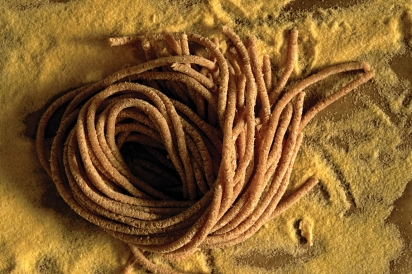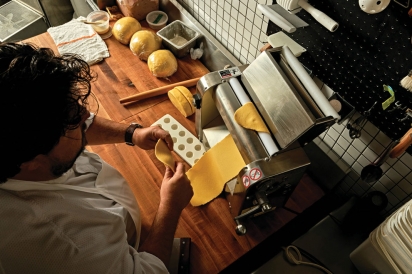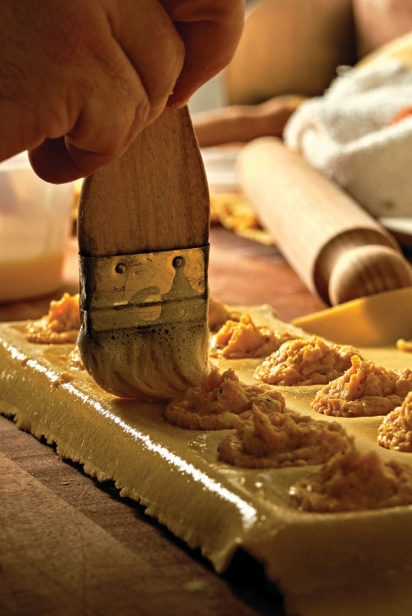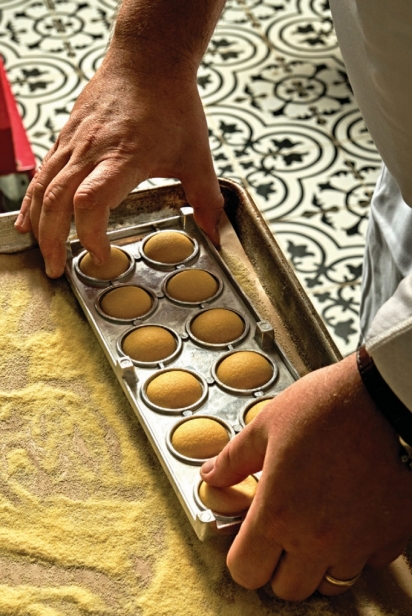Anthony Lombardo Puts his Stamp on Ravioli
ON A LATE AFTERNOON at SheWolf Pastificio & Bar in midtown Detroit, the staff meticulously prepares for the night’s service, dressing tables inside and out, working like a fine-tuned machine until the time when roughly two dozen front-of-house staff members—servers, hosts, bussers, managers and more—gather around the restaurant’s central square bar to hear details about the night’s menu.
Behind the scenes, the kitchen staff busily preps food for the evening, including those whose job it will be to work within the pastificio, a glassed-in pasta studio, in a far corner of the dining room.
There, co-owner and chef Anthony Lombardo discusses which pastas are on the night’s list, including a francobolli, a ravioli named for its resemblance to a postage stamp. At SheWolf, Lombardo and his team not only make their own pasta, they mill their own flour, which could be as much as 300 pounds a week.
“We’re very serious about our pasta and it’s the main ingredient,” says Lombardo, pointing out that many mass-produced flours have preservatives to make them shelf stable. He also mills to use local ingredients as much as possible: “Michigan has a lot of beautiful wheat fields.”
“Milling became a thing for us because we’re a pasta house,” says Lombardo. A bakery needs much more consistency when they mill. Flour for pasta “can be a little different every time and it will still be a delicious pasta because you have more humans touching it who can fix it.”
Lombardo calls the difference between freshly milled flour and store-bought “night and day,” because of both texture and flavor.
“Every pasta on our menu has a different wheat combination,” says Lombardo. For example, ravioli uses milled golden durum wheat flour; tonnarelli, a spelt and soft white combination.
“When I think about a pasta, I think about a final dish,” says Lombardo. “With every shape I think of the sauce that would be compatible with that shape. Gnocchi isn’t going to absorb the sauce like a cavatelli.”
These four pasta-making processes—each using varied doughs and equipment—are among the most common:
Extruded pasta is when a machine extrudes—pushes—pasta dough through a machine fitted with a die to produce pasta in a desired shape. Some examples include: macaroni, spaghetti and tonnarelli (seen here, as made at SheWolf).
Sheeted pasta is the basis for lasagna or ravioli and is made by a pasta machine or by hand using a rolling pin, continually pressing sheets until they reach the desired thickness and consistency.
Sfoglia has several meanings in Italian, including puff pastry and thin-layered. This staple of Italy’s Emilia-Romagna region is an egg pasta that is hand-rolled with a wooden rolling pin, before being shaped by hand to form tortellini, tagliatelle, and other similar pasta.
Gnocchi—is it pasta or a dumpling? Some say Italy’s well-loved little dumpling can fit into either classification. Traditionally made with potatoes or ricotta cheese, gnocchi is made by rolling dough into strips, which are then cut into smaller pieces and shaped.










